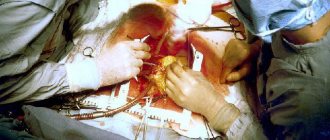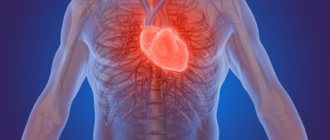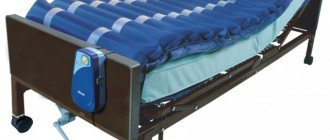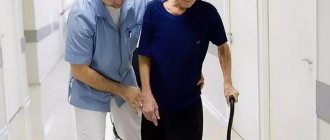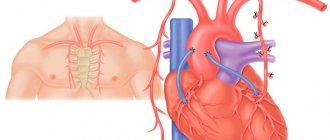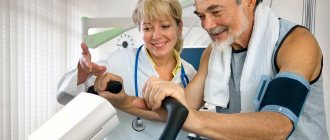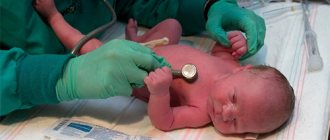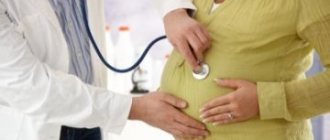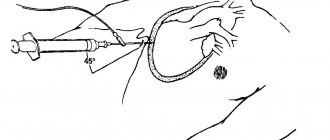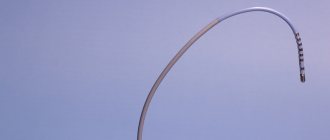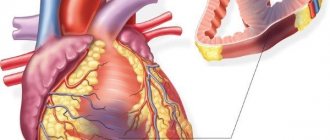Why does arrhythmia occur after surgery?
You've probably seen in some movie what doctors do when a patient's heart stops.
Two electrodes in the form of “irons” are applied to the chest, to which an electric current is applied. A strong shock is passed through the patient's body, this helps restore the heartbeat. Cardioverter-defibrillators work in a similar way. These devices look very similar to pacemakers, but have an additional function. They are installed if:
- there is a high risk of developing the most dangerous types of arrhythmias - ventricular tachycardia or ventricular fibrillation;
- The patient has already experienced sudden cardiac arrest or is at increased risk for this condition.
Cauterization of the myocardium (radio wave ablation), installation of a valve prosthesis or shunt, or the use of anesthesia can lead to rhythm disturbances during cardiac surgery. Depending on the cause and the initial condition of the patient, the rhythm is restored or causes complications - ventricular asystole, acute circulatory disorders, thromboembolism. For treatment, medications, defibrillation, and pacemakers are used.
What does cauterization mean for treatment of cardiac arrhythmia? Let’s discuss this procedure and find out how it is carried out. When diagnosed with cardiac arrhythmia, the treatment that turns out to be the most effective and efficient is cauterization, or, in other words, minimally invasive ablation. A small, strictly defined area of the heart muscle is cauterized using a catheter.
The required area is determined by special studies. Normally, the heart muscle contracts at regular intervals with an average frequency of 60–90 beats/min. The number of muscle contractions per minute can decrease or increase, depending on the current needs of the body.
Cardiac arrhythmia, in other words, a violation of the frequency and sequence of the heart rhythm, and there can be many reasons for its occurrence - stress, overload, diseases of various organs and systems of the body, and arrhythmia can also be a consequence of congenital human diseases.
It can be either an independent disease or a symptom of another disease. There are different types of arrhythmias, some of them can go away on their own, others require mandatory and urgent treatment.
Both medications and surgical methods are used to treat cardiac arrhythmias. However, the effectiveness of drug treatment is not very high, so many are faced with the need for surgical intervention.
Modern cardiology is focused on minimally invasive methods of treating cardiac arrhythmia, i.e., those that do not require open heart surgery. Treatment of cardiac arrhythmia by cauterization is just such a method of treatment, aimed at minimizing the area of intervention in the body.
Causes of postoperative cough
Cough after surgery can occur for several reasons. First of all, it is worth considering the option of using an endotracheal tube. Its role is reduced to providing ventilation of the lungs, both during abdominal and some endoscopic operations. The tube is inserted directly into the throat and, therefore, there is a fairly high risk of injury to the mucous membranes of the larynx and trachea. This may happen as a result of:
- Individual structural features of bones and organs in the mouth and throat. This may be a short neck or a large amount of fat deposits,
- Duration of use of the tube. Some diagnoses require hours-long operations, and this increases the risk of damage to the throat mucosa,
- Urgency of tube insertion. Unfortunately, it is not uncommon for an operation to be started urgently, which means that the medical team performs all manipulations very quickly. In such conditions, the anesthesiologist can insert a tube, injuring the mucous membranes.
But it is not only the tube that can become the source of cough that appears after surgery. Other reasons include:
- The use of medications during surgery that cause severe drying of the mucous membrane of the larynx and trachea,
- Irritation of the respiratory tract due to the entry of stomach contents into them. This case is likely if the recommended period of fasting was not followed before the operation,
- Nature of the operation. If surgery was performed on the area of the respiratory organs and tract, then there is a high probability of coughing in the postoperative period,
- Long-term smoking. If a patient has been smoking cigarettes for several years, he may develop a cough as a reaction of the body to particles of tar remaining in the lungs.
And, of course, you should not lose sight of such an option as the appearance of a common cold or other viral disease. Due to the fact that the immune system is significantly weakened when using anesthesia, there is a fairly high chance of getting sick after surgery.
Types of operation
If one artery is damaged, one shunt is required. If two or more are damaged, then two or more shunts are inserted.
There are certain types of CABG in the world:
- When artificial circulation is turned on and a set of measures is created to protect the myocardium, during a period of temporary heart failure;
- Without connecting extracorporeal circulation, the risk of complications is reduced, but caution and an experienced surgeon are required;
- With endoscopic surgical interventions, the smallest incisions are made with or without extracorporeal circulation; with this type of operation, the wound heals quickly.
Vascular graft used for coronary artery bypass grafting:
- autovenous – the patient’s venous vessel;
- autoarterial – patient’s radial artery;
- mammocoronary - the internal thoracic artery of the patient.
Coronary artery bypass grafting is selected for patients individually.
Carrying out CABG
Coronary artery bypass surgery on a beating heart begins with providing access to the operation site - the skin, subcutaneous layers, and muscles are cut layer by layer.
A graft (shunt) - a healthy section of a vein or artery - is taken from the patient's chest or limb (thigh, lower leg). To perform surgery on a beating heart, special equipment is used to stabilize the myocardium at the site of the anastomosis. One end of the healthy vessel is sutured to the aorta, the other to the coronary artery below the stenotic/narrowed area. Then full heart function is restored, the wound is sutured, and the patient is transferred to the intensive care unit.
Coronary bypass surgery in most clinics is performed with cardiac arrest using a heart-lung machine. The use of this method is associated with the risk of complications that prolong recovery time, worsen recovery, and can lead to bleeding, stroke, and heart attack. Carrying out surgery without artificial circulation - on a beating heart - reduces the risk of postoperative complications.
Diagnosis of the patient
The main method for determining rhythm disturbances is an ECG. It is carried out after heart surgery in 24-hour monitoring mode. In the long-term period, to assess the effectiveness of treatment, stress tests can be additionally used to study the resistance of the myocardium to increased physical activity and lack of oxygen.
The following tests are used for this:
- stress Echo-CG;
- electrophysiological diagnostics;
- tilt test with changing body position;
- bicycle ergometer;
- treadmill;
- cold test;
- administration of pharmacological drugs.
In what cases is diagnostics necessary and how is it carried out?
It is strongly recommended to consult a doctor if the cough does not go away on its own after 3 days, and also if it is accompanied by pronounced painful symptoms. At the appointment, the doctor will definitely get acquainted with the patient’s complaints, listen to the patient’s lungs and evaluate his external condition. But this is not enough to make an accurate diagnosis.
Additional examination methods include:
- General blood analysis. Its result can confirm the presence or absence of an inflammatory process in the body,
- Radiography. A familiar procedure that displays the condition of the lungs,
- Sputum culture. If present, the patient may be scheduled to submit a sample for laboratory analysis. He is able not only to identify the presence of pathological pathogens, but also to select antibiotics to which they will be sensitive,
- Bronchoscopy. This is a fairly serious examination method, which consists of assessing the condition of the respiratory tract, trachea and bronchi using special equipment.
After all the necessary procedures have been carried out, the doctor will be able to determine an accurate diagnosis and prescribe treatment.
Drug treatments for cardiac arrhythmia
In the absence of postoperative complications and severe concomitant diseases, patients are sent to a specialized rehabilitation department, and then to the cardiology department of the sanatorium. Contraindications for transfer after CABG are: frequent and prolonged attacks of exertional and resting angina, unstable angina;
fresh myocardial infarction; circulatory failure IV f.kl. NYHA; severe rhythm disturbances; severe arterial hypertension with damage to internal organs, difficult to correct; postoperative complications;
At the stage of sanatorium rehabilitation, it is necessary to consolidate the effect of surgical and drug treatment received at the inpatient stage, to adapt the patient to the upcoming everyday stresses, social communication, and work activities.
The objectives of the sanatorium stage are as follows: development and application of optimal training programs; determining the individual rate of activation depending on the nature, adequacy of the surgical intervention and the compensatory capabilities of the body;
At the outpatient stage, the main tasks are the development of the body’s compensatory capabilities in order to restore working capacity, prevent possible exacerbations of coronary artery disease, and combat risk factors.
Evaluation of the effectiveness of rehabilitation is based on changes in the nature of the disease (disappearance of angina attacks, their reduction; an angina attack occurs when performing a load of greater or lesser intensity);
the need to take medications; changes in the level of physical performance, including tolerance to household and industrial stress (assessed based on the results of VEP, daily ECG monitoring and other functional tests.
One of the complications after CABG surgery is occlusion of autovenous shunts. There is currently no evidence that any medications, including antithrombotics, can prevent the development of late occlusions occurring more than 1 year after surgery.
Surgical correction of valvular heart disease is only one of the stages in the treatment of these patients. After discharge from a cardiac surgery hospital, a patient with an artificial heart valve requires constant close monitoring by a rheumatologist or general practitioner at the place of residence and drug maintenance therapy.
Gradual normalization of the function of the cardiovascular system after adequate surgical correction of heart disease occurs within 1-2 years. During the first year after surgery, the patient should be examined by a doctor monthly.
During a clinical examination, the doctor finds out the subjective state of the patient, the presence of shortness of breath, pain in the heart, palpitations, clarifies the degree of decompensation, evaluates the operation of the artificial heart valve, and the presence of murmurs.
The main tasks of the doctor during clinical observation of patients with artificial heart valves are: prevention of exacerbation of rheumatism, anticoagulant therapy, treatment of circulatory failure and heart rhythm disturbances when they occur, timely identification of specific complications.
In some patients, after heart valve replacement, signs of circulatory failure remain to varying degrees. Therefore, after discharge from the hospital, it is necessary to continue the constant intake of cardiac glycosides (digoxin, Celanide, Isolanide, Lanicor) under control of the pulse rate.
The presence of bradycardia in a patient is an indication for the prescription of myofedrine. In case of severe decompensation (enlarged liver, swelling in the legs), diuretics (furosemide, uregitis) are prescribed. When using them, potassium preparations (panangin, asparkam) are prescribed to avoid hypokalemia.
One of the mandatory elements in the treatment of circulatory failure is the use of angiotensin-converting enzyme inhibitors - lisinopril, beolipril, diroton or vasodilators (nitrosorbitol, nitrogranulong, prazosin), which are prescribed in normal doses, taking into account tolerability and blood pressure levels.
To improve myocardial metabolism, Riboxin, Retabolil should be prescribed. Vitamin B12, potassium orotate, and folic acid have some anabolic effects. It is advisable to carry out courses of this treatment 2 times a year. Patients need to limit fluids and salt.
In case of persistent heart failure, the patient requires hospitalization in a therapeutic hospital, where he is recommended to limit his physical activity and is prescribed intravenous infusions of a potassium-polarizing mixture, cardiac glycosides, and diuretics.
In case of severe decompensation, an infusion of nitrates (1% nitroglycerin solution or 0.1% isoket) is prescribed, under the control of blood pressure levels, which should not decrease less than 100 mm Hg. Art. Agents that improve myocardial metabolism are also used.
In case of unstable hemodynamics, a combination of peripheral vasodilators and catecholamines (dopamine, dobutrex) is possible. Recently, a new class of drugs from the group of phosphodiesterase inhibitors (amrinon, vincoram) has proven itself well for the treatment of congestive heart failure.
In the postoperative period, it is very important to note all the patient’s complaints and promptly prevent negative consequences associated with the installation of a shunt. To do this, the wounds are treated daily with an antiseptic solution and an aseptic bandage is applied.
In some cases, the patient may develop anemia, which is a consequence of significant blood loss. In this case, it is recommended to follow an iron-rich diet to restore hemoglobin levels. If this does not help, the doctor prescribes iron supplements.
With insufficient physical activity, pneumonia can occur. To prevent it, breathing exercises and physical therapy are used.
An inflammatory process sometimes appears in the area of the sutures, which is associated with an autoimmune reaction of the body. Treatment of this pathology consists of anti-inflammatory therapy.
Quite rarely, complications such as thrombosis, renal failure and insufficient restoration of the sternum can occur. In some cases, the patient has a closure of the shunt, as a result of which the operation does not bring any effect, i.e.
turns out to be useless. A comprehensive examination of the patient before surgical treatment will help prevent the development of these problems in the postoperative period. You will also need to periodically visit a doctor from the moment you are discharged from the hospital and monitor your health.
In addition, complications may develop if the operation was performed in the presence of direct contraindications. These include diffuse lesions of the coronary arteries, oncological pathologies, chronic lung diseases, and congestive heart failure.
During the postoperative period, various complications may arise that affect the patient's further condition. The patient must understand that his health is only in his hands and behave correctly after the operation.
How to increase blood pressure at home
Hypotension is a condition characterized by low blood pressure. It can occur in any person, regardless of age and gender, under the influence of negative factors.
- Blood pressure norms
- Causes of hypotension
- Symptoms of hypotension
- Danger of pathology
- Ways to increase your blood pressure yourself
- Drug treatment
- Diet
- ethnoscience
Low blood pressure, unlike high blood pressure, is not considered a dangerous pathology, but can cause a lot of unpleasant symptoms, including loss of consciousness. It is important to take timely therapeutic measures when identifying the first signs of hypotension.
Blood pressure norms
Arterial blood pressure is the pressure exerted by the blood on the walls of blood vessels due to the action of the heart.
There are two pressure indicators:
- upper - with maximum contraction of the heart muscle;
- lower - at the moment of greatest relaxation of the heart.
In an adult who does not have serious abnormalities or diseases, the norm is considered to be 120(115)/80(75) mm Hg. Art.
Hypotension is diagnosed with the following indicators:
- in women - 90/60;
- in men - 100/65;
- in older people - 110/70.
Causes of hypotension
Low blood pressure is interconnected with the processes occurring inside the body, the functioning of the nervous and cardiovascular systems.
Hypotension appears in the following conditions:
- A decrease in the amount of blood occurs when there is massive blood loss or dehydration of the body.
- Heart contractions slow down, their strength decreases - the weaker and less often the heart muscle pushes out blood, the lower the pressure exerted on the walls of blood vessels. Pathology can occur during a long period of rest.
- Poor functioning of nerve endings, which are considered a compensatory mechanism and control the stability of pressure by sending special impulses to the brain. Dysfunction of nerve tissue can be caused by internal and external influences.
- A sharp and strong narrowing or contraction of blood vessels, due to which a small volume of blood enters the arteries.
These conditions can occur either independently or several at once.
Reasons that cause a decrease in blood pressure include:
- the presence of diseases manifested by hypotension;
- regular lack of sleep, overwork, exposure to stressful situations, prolonged insomnia, nervous agitation;
- depression;
- malnutrition, dehydration, insufficient blood sugar;
- oxygen deficiency;
- taking certain groups of medications, excessive use of sedatives, soothing teas;
- eating foods that help lower blood pressure;
- long sleep, lack of exercise;
- long intellectual loads;
- severe injuries, blood infections, bleeding;
- pregnancy;
- poisoning;
- avitaminosis;
- change of time zone, climate.
Symptoms of hypotension
Low blood pressure is not a dangerous pathology, but you should pay close attention to how you feel if the following symptoms occur:
- Loss of consciousness, lightheadedness, dizziness.
- Headaches, especially those that occur in the morning (the area of distribution of pain signals is varied - in the area of the crown, temples, back of the head, forehead, the nature of the sensations can be anything - squeezing, migraine, dull, pulsating).
- Defocus of vision, darkening, appearance of “floaters” before the eyes. Signs often appear with a sudden change in body position, indicating orthostatic hypotension.
- Noise, ringing in the ears, the appearance of a sensation of sound being conveyed through glass or film.
- Weakness, low tone, drowsiness.
- Numbness, coldness of the hands and feet.
- Blueness, pale skin, low pulse.
- Feelings of lack of air - a person cannot take a deep breath.
- Heartburn, belching air.
- Pain that occurs in the chest, heart, shortness of breath.
With a regular decrease in blood pressure, you may experience:
- rapid rhythmic movements of the body and limbs caused by muscle contractions;
- irritability, tearfulness;
- failures in coordination of movements;
- staggering while walking;
- difficulty concentrating;
- low mental activity, absent-minded attention;
- frequent yawning.
Danger of pathology
Low blood pressure does not pose a serious threat to life, but in some cases complications develop:
- oxygen deprivation caused by slow blood flow;
- if the tonometer readings are excessively low, there is a possibility of developing renal failure;
- frequent loss of consciousness can cause serious injuries;
- low pressure in blood vessels when the body is dehydrated causes nausea and vomiting;
- when there is a lack of oxygen in pregnant women, there is a danger to the life of the fetus;
- stroke;
- cardiogenic shock;
- in combination with a slow pulse and tachycardia, hypotension is life-threatening.
Ways to increase your blood pressure yourself
Medications are rarely used to bring blood pressure levels back to normal. To increase blood pressure, experts recommend using homeopathic remedies, medicinal plants, and changing your lifestyle and diet.
If the pressure has dropped sharply, there are emergency first aid methods to increase it at home:
- Perform acupressure for several minutes - movements should be circular and soft.
- Drink strong fresh coffee with lemon. The drink should not be cold; you should drink it in small sips. Instead of coffee, you can use hot green tea without various additives.
- If your blood pressure drops significantly, you should lie down. The legs should be higher than the head - this will promote the outflow of blood from the extremities. At the same time, you can breathe in the vapors of essential peppermint oil.
- A tablet of caffeine or Citramon will quickly raise blood pressure.
For hypotension it is recommended:
- perform lymphatic drainage massage or body massage;
- sleep at least 8 hours;
- do not suddenly get out of bed after sleep: you need to lie down, performing slow, circular movements with your limbs, and after exercise you should sit in bed and stretch.
- regularly take walks in the fresh air, engage in race walking, light jogging, swimming;
- taking a contrast shower helps overcome feelings of malaise;
- avoid sudden temperature changes, if possible try not to go into hot and stuffy rooms;
- get rid of bad habits, normalize your daily routine;
- Have a full breakfast and don’t skip meals during the day.
Drug treatment
Medicines are rarely used for low blood pressure, but there are certain medications used to normalize the condition:
- Gutron;
- No-Shpa, Spasmalgon and other medications that relieve spasms;
- Papazol;
- Ibuprofen, Nise, other analgesics;
- Camphor;
- Mezaton;
- Dobutamine.
For patients who have low blood pressure, experts recommend using tinctures:
- Eleutherococcus;
- Chinese lemongrass;
- Leuzea;
- ginseng;
- Rhodiola rosea.
If you are prone to hypotension, you should take tinctures twice a day 20–30 minutes before meals. The number of drops depends on the individual characteristics of the body.
Diet
To normalize low blood pressure yourself, you can use certain foods.
Drinks and foods that contain caffeine are best for this. In addition to coffee and green tea, such products include Hibiscus tea, cocoa, and dark chocolate. In emergency situations, you can drink Coca-Cola and Pepsi-Cola, but you should not abuse soda and caffeine.
Salt and fats increase blood pressure. Hypotension can be normalized by dissolving a pinch of salt.
You need to drink enough water. The liquid helps thin the blood and increase its volume.
To raise blood pressure, you should include in your diet:
- cottage cheese, cheese;
- dried apricots, sea buckthorn, lemon, black currant, cherry;
- rice, buckwheat;
- potatoes, carrots, beans, sorrel;
- butter, eggs;
- fish, caviar;
- liver, red meat;
- fresh pomegranate or its juice;
- horseradish, onion, garlic, salted nuts.
It is worth adding more foods containing iron and vitamins A, D, C, E, P to the menu.
ethnoscience
Traditional medicine advises fighting hypotension with the help of herbal infusions, decoctions and extracts. The following plants are commonly used:
- St. John's wort;
- immortelle;
- echinacea;
- thistle.
If a person often experiences attacks of hypotension, the first thing to do is get rid of the causes that cause this condition.
It is important to be attentive to your health. If you cannot get rid of the pathology on your own, you should consult a doctor.
- 09/21/2015 at 03:08
– by leaving a comment, you accept the User Agreement
- Arrhythmia
- Atherosclerosis
- Varicose veins
- Varicocele
- Vienna
- Haemorrhoids
- Hypertension
- Hypotension
- Diagnostics
- Dystonia
- Stroke
- Heart attack
- Ischemia
- Blood
- Operations
- Heart
- Vessels
- Angina pectoris
- Tachycardia
- Thrombosis and thrombophlebitis
- Heart tea
- Hypertension
- Pressure bracelet
- Normalife
- Allapinin
- Asparkam
- Detralex
Atrial fibrillation after heart surgery
Coronary artery bypass surgery is a serious reason to reconsider your previous lifestyle. In order to prolong your life, it is very important to completely stop drinking alcohol and smoking.
This is exactly the case when the choice between a familiar and healthy lifestyle becomes very important. A significant factor that helps to avoid re-exacerbation of the disease is diet after bypass surgery of the heart muscle vessels.
Every patient who has undergone surgery should reduce their intake of foods saturated with fat and reduce their intake of salt and sugar. It is very important to strictly monitor fluctuations in weight.
Large amounts of fats and carbohydrates contribute to the clogging of blood vessels, increasing the risk of the disease returning. After surgery, the slogan for a person should be the phrase “moderation in everything”!
It is extremely important to remember that coronary artery bypass grafting is not a solution to the underlying problem, not a treatment for atherosclerosis. After discharge from the hospital, you must adhere to the doctor’s recommendations, do not neglect them, follow all the doctor’s instructions and enjoy the gift of life!
Drug therapy for heart failure (HF) involves the use of angiotensin-converting enzyme inhibitors (ACEIs), diuretics, cardiac glycosides, β-blockers, and extended-release nitrates.
Combinations of various vasodilators (for example, hydralazine nitrates) are also used, which are an alternative if ACE inhibitors, cardiac glycosides, and β-blockers are poorly tolerated. The selection of drug doses depends on the functional class of heart failure.
Treatment of heart failure begins with the prescription of angiotensin-converting enzyme inhibitors. The therapeutically active dose of the drug is prescribed strictly individualized depending on hemodynamic parameters (starting with the minimum, gradually increasing to the maximum tolerated).
With long-term heart failure, secondary aldosteronism develops, as a result of which long-term administration of aldosterone antagonists (spironolactone, veroshpiron) 25 mg once a day is pathogenetically justified.
Combining aldosterone antagonists with ACE inhibitors allows, on the one hand, to reduce the dosage of diuretics, and on the other hand, to block the negative effect of long-term use of ACE inhibitors on the activity of the renin-angiotensin-aldosterone system.
When treating heart failure, we must not forget about the secondary activation of the sympathoadrenal system, which is corrected by the administration of β-blockers. For patients in whom the radial arteries were used as shunt material, it is better to prescribe drugs with alpha-adrenomimetic action (carvedilol group). Treatment should be prescribed with minimal doses, gradually increasing them to the target.
The prescription of peripheral vasodilators (intravenously - sodium nitroprusside, isosorbitol dinitrate, per os - molsidomine, long-acting nitrates) is used in case of decompensation of the pulmonary circulation.
Sometimes therapy with ACEIs, diuretics, β-blockers and peripheral vasodilators is ineffective. In this case, especially in the presence of a tachysystolic form of atrial fibrillation, the administration of cardiac glycosides is indicated.
Phosphodiesterase inhibitors (amrinone) have a positive inotropic and vasodilating effect. They are used only intravenously under careful monitoring of hemodynamic parameters. Patients after surgical revascularization of the myocardium in the postoperative period often develop heart rhythm disturbances: sinus tachycardia, atrial fibrillation, ventricular or supraventricular extrasystole, bradycardia.
For sinus tachycardia (if its presence is not caused by circulatory failure, the presence of fluid in the pericardial cavity and/or pleural cavities, hyperthermia as a manifestation of postcardiotomy syndrome, hyperkalemia, etc.
) it is necessary to quit smoking, abuse coffee, tea and alcohol, limit the intake of drugs prescribed for the treatment of concomitant pathologies that can contribute to an increase in heart rate (alupent, isadrin, etc.).
Sinus tachycardia in the postoperative period may be a consequence of anemia. In this case, its correction is necessary (up to the transfusion of single-group red blood cells).
Drug treatment involves the use of β-blockers and calcium antagonists (verapamil and diltiazem). Correction of possible hypokalemia and hypomagnesemia is also necessary.
Supraventricular extrasystole - drug treatment is carried out for frequent extrasystole, allorhythmias and requires the prescription of sedatives, β-blockers, calcium antagonists, cardiac glycosides for heart failure, potassium preparations for intoxication with glycosides, diphenine (0.1 x 3 times a day).
a) atenolol – continuation of a previously started dose; if not previously used, for the prevention of MA, 50 mg 2 times a day is prescribed at least 72 hours before surgery; b) sotalol - 160 mg in the morning before surgery, then 160 mg 2 times a day after surgery;
c) cordarone – 600 mg per day 7 days before surgery and 200 mg per day after surgery; cancellation upon transfer to the sanatorium stage; d) digoxin and calcium antagonists are not sufficiently effective in preventing postoperative MA.
- the size of the left atrium is more than 60 mm; - pronounced cardiomegaly; - bradysystolic form of atrial fibrillation; - clinical picture of sick sinus syndrome before the appearance of atrial fibrillation; - the presence of blood clots in the cavities of the heart;
It is necessary to begin restoring sinus rhythm with intravenous medications. Preference is given to cordarone. If there is no effect from intravenous administration of cordarone, as well as with increasing signs of left ventricular failure caused by paroxysmal AF, electrical pulse therapy is performed.
After restoration of sinus rhythm, in order to prevent relapses of AF, long-term use (4-6 months) of cordarone, beta-blockers, sotalol or individually selected combinations of antiarrhythmic drugs (cordarone, quinidine, finoptin, etc.) is indicated.
The occurrence of bradysystole in the postoperative period requires an individualized approach to treatment.
Sinus bradycardia, not accompanied by hemodynamic disturbances, does not require treatment. With the development of hemodynamically significant bradysystolic rhythm disturbances (fainting, loss of consciousness, Morgagni-Adams-Stokes attacks, hypotension, etc.), it is necessary to decide on the implantation of a permanent pacemaker.
Anticoagulant therapy is indicated for all patients with mechanical or biological artificial heart valves (ICS). Warfarin therapy is currently the most optimal due to its predictable, long-lasting anticoagulant effect and once-daily dosing.
Warfarin is prescribed on the second postoperative day under the control of the international normalized ratio (INR), which should be 2.5-3.5. Patients with mechanical prostheses must take warfarin continuously.
Patients with first generation mechanical heart valves (Starr-Edwards, ACH, MKCH) should receive warfarin at a dose that provides an INR of 3.0-4.5. Patients with second generation mechanical heart valves (Planix, Medinge, St.
Jude Medical, Medtronic,) in the aortic position in the absence of atrial fibrillation and normal left atrium size should receive warfarin in a dose that provides an INR of 2.0-3.0. If the valve is installed in the mitral position, the dose of warfarin is increased to an INR of 2.5-3.5.
In patients with mechanical ICS and systemic embolism, the addition of aspirin (80-100 mg per day) against the background of warfarin prophylaxis is recommended.
Patients with mitral and aortic bioprostheses should receive warfarin (INR 2.0-3.0) for 3 months after surgery. If there is a history of systemic embolism, therapy is extended to 12 months.
After heart valve replacement, most patients experience various heart rhythm disturbances - sinus tachycardia, ventricular and atrial extrasystole, atrial fibrillation (especially its tachysystolic form), which negatively affect hemodynamics.
To diagnose arrhythmias, it is necessary to carry out electrocardiographic monitoring. If rhythm disturbances are detected, drug treatment is indicated, taking into account the suspected cause of their occurrence. The causes of rhythm disturbances may be: electrolyte imbalance, current rheumatic carditis, myocardial changes during prolonged circulatory decompensation, coronary insufficiency, and neuropsychiatric disorders.
- After the operation, the patient is taken to the intensive care unit, where the functionality of the heart muscle and lung function are restored. The duration of the period is 10 days. Initial rehabilitation is carried out in the hospital, further procedures take place in a rehabilitation center.
- The suture on the chest at the place where the material for the shunt was taken is washed with antiseptics to avoid contamination and suppuration. Stitches are usually removed on day 7. The wound may cause burning and pain for some time, but this will go away over time. And only after one or two weeks of wound healing of the skin is it possible to take a shower.
- The bone in the sternum takes a very long time to heal – 4-6 months. Chest bandages are used to promote rapid healing.
- To avoid stagnation in the veins on the legs and to prevent thrombosis, wear elastic stockings, but most importantly, you need to give up physical activity for a while.
- Due to the large loss of blood during the operation, the patient may develop anemia, so all that is necessary is to eat foods containing iron; after a certain time, hemoglobin will resume.
- To avoid pneumonia, when normal breathing is restored, the patient will need to do breathing exercises every day. Coughing is an important part of recovery after surgery. To make it easier, press your palms to your chest.
- Once you have fully recovered, you can gradually increase physical activity. Angina attacks stop. Spend most of your time walking.
- After 2-3 months or earlier, the patient can begin to work, depending on what kind of activity the person is engaged in. If the work is labor-intensive and involves physical activity, then it is recommended, if possible, to change your place of work to a more or less easy one.
- Disability after coronary artery bypass surgery is given to a patient who, due to his health, is limited in work activity. After rehabilitation, a commission is passed to recognize the patient as disabled. Disability is identified individually in a specific situation.
- After at least 2 months, the patient is checked using a special stress test to detect pain and ECG changes. If all this turns out to be normal, then the patient has successfully completed the recovery.
- Heart surgery
- Brain surgery
- Surgery on the abdominal aorta
- Rehabilitation period
Preparation for coronary artery bypass surgery
At the Federal Scientific and Clinical Center of the Federal Medical and Biological Agency, before performing coronary artery bypass surgery, the doctor draws up a preoperative examination plan. It includes laboratory tests and instrumental studies:
- general blood test, urine test;
- blood biochemistry;
- expanded coagulogram;
- ADP platelet aggregation;
- blood type and Rh factor;
- markers of infections: HIV, hepatitis B, hepatitis C, syphilis;
- Pro-BNP, SRP;
- ECG;
- Echo-CG;
- X-ray examination;
- EGDS (maximum duration – 1 month). An exception is patients with lesions of the left artery trunk;
- Ultrasound scanning of the brachiocephalic arteries (maximum duration – 3 months);
- Ultrasound scanning of the arteries of the lower extremities (maximum duration – 3 months);
- Ultrasound scanning of the veins of the lower extremities (maximum duration – 7 days);
- FVD (maximum duration – 7 days);
- Ultrasound of internal organs;
- coronary angiography.
If there is a concomitant pathology, additional tests may be prescribed:
- History of stroke - CT scan of the brain.
- thyroid diseases - TSH, T4, T3 (maximum duration - 30 days). Consult an endocrinologist if there are changes in the hormonal profile.
- diabetes mellitus - glycemic curve (maximum duration - 7 days). Consultation with an endocrinologist for glycemia more than 10 mmol/l.
- Gout - uric acid (maximum duration - 1 month). If the value exceeds 420 µmol/l, consult a therapist and select therapy.
- consultation with a dentist, urologist, gynecologist.
The day before surgery, the patient is examined by a surgeon and an anesthesiologist. On the eve of CABG, it is recommended to have a light dinner no later than 12 hours before surgery, not to eat or drink the night before, and to stop taking medications. A cleansing enema is given at night. In the morning the patient takes a shower.
After signing the informed consent, the patient is given premedication - medications are administered that will reduce emotional tension and help calm down. After 40-60 minutes, the patient is taken to the operating room.
At the cardiology center of the Federal Scientific and Clinical Center of the Federal Medical and Biological Agency, you can take all the tests and undergo studies recommended by your doctor before the operation. The structure of our center allows you to quickly go through the preparatory preoperative stage and get the results in hand. Having our own laboratory, we are responsible for the accuracy of tests and the quality of clinical and laboratory studies.
Drug therapy for heart failure
Some drugs can restore normal rhythm when it is unstable, if the heart beats faster or slower. A cardiologist may prescribe procainamide, amiodarone, propafenone, disopyramide, flecainide.
Many antiarrhythmic drugs have serious side effects; if used incorrectly, they can not only eliminate, but also aggravate arrhythmia. They should not be taken without a doctor's prescription.
With atrial fibrillation and some other heart rhythm disorders, the flow of blood in the chambers of the heart is disrupted, resulting in an increased risk of blood clots. In order to prevent this complication, blood thinning medications are used.
There is no effective drug treatment for arrhythmias accompanied by bradycardia (slow heart rate). Such patients are most often indicated for implantation of a pacemaker.
Arrhythmia is usually a symptom of existing pathologies:
- ischemic disease;
- heart failure;
- arterial hypertension.
Medicines prescribed to relieve symptoms stop the progression of the underlying disease. These include:
- Diuretics;
- Statins;
- Beta-adrenergic blockers;
- Sortans
- Specially developed antiarrhythmic drugs (“Amiodarone”, “Propafenone”, “Sotalol”) are capable of equalizing the heart rate of a heart working in an unnatural rhythm.
These medications should be taken for quite a long time. At the same time, you should streamline your regimen, avoid stressful situations, and also follow a special diet without smoking and alcohol. Remember that only a doctor can prescribe medications!
Surgeries for arrhythmia are indicated only in cases where drug treatment does not bring results. Among the effective and reliable methods, the following stand out:
- insertion of a pacemaker;
- defibrillator implantation;
- radiofrequency ablation.
A pacemaker is a box that contains an electronic device and a battery. There are two wires connected to it. During the operation, wires are passed through the vessels to the atrium and ventricle.
During surgery, local anesthesia and a 3-4 cm incision are made. The pacemaker delivers electrical impulses that irritate the myocardium and sets the correct heart rhythm. Such devices last for 10 years.
A defibrillator is similar in its characteristics and purposes to a pacemaker. Its electrical discharges normalize heart rhythm and eliminate arrhythmia. After an incision is made in the chest, the electrodes are directly inserted and adjusted.
Radiofrequency ablation (RFA) was developed at the end of the last century. It is less invasive and has positive reviews not only from patients, but also from leading specialists. Through special punctures, a procedure is carried out to cauterize problem areas. RFA completely cures the patient of many types of heart rhythm disorders.
Coronary bypass surgery, complications
•Cardiology•Coronary artery disease•Coronary artery bypass grafting, complications
There are many factors that influence the incidence of complications and mortality after coronary artery bypass grafting.
Recent myocardial infarction, unstable hemodynamics, left ventricular dysfunction, damage to the left main coronary artery, severe and unstable angina, as well as atherosclerosis of the peripheral and especially carotid arteries worsen the prognosis. The risk of perioperative complications is increased in the elderly, diabetics, and women.
The results of the operation are also influenced by the severity of intraoperative myocardial ischemia and the type of shunt: after mammary coronary bypass surgery the long-term prognosis is better.
A serious complication of coronary artery bypass grafting is perioperative myocardial infarction
.
It develops more often in women, in patients with severe angina, severe stenosis of the left main coronary artery and three-vessel disease, as well as in patients with unstable angina and against the background of prolonged artificial circulation.
Perioperative myocardial infarction, especially complicated by hemodynamic disturbances and arrhythmias or occurring against the background of initial left ventricular dysfunction, significantly worsens the short-term and long-term prognosis.
Diagnosis of myocardial infarction is complicated by the nonspecific ECG changes inherent in coronary artery bypass surgery and the postoperative increase in the activity of cardiac isoenzymes.
The postoperative period is often complicated by respiratory disorders, but serious lesions rarely occur, mainly in COPD and in the elderly.
Typical complications of coronary artery bypass surgery are blood clotting disorders and bleeding.
. Repeated operations for bleeding are required in 2-5% of patients.
In addition to the destruction of platelets, artificial circulation leads to disruption of fibrinolysis and the internal coagulation mechanism.
Risk factors for bleeding include older age, small body surface area, repeated surgery, use of both internal mammary arteries, and preoperative use of heparin, aspirin, and thrombolytics.
Mediastinitis and suture failure
occur in approximately 1% of patients: these complications significantly increase hospital mortality, the risk of other complications and length of hospitalization. The likelihood of mediastinitis and suture failure increases sharply when both internal mammary arteries are used, especially in patients with diabetes.
Stroke
occurs in 1-5% of patients, the risk increases with age. Slow recovery of consciousness is observed in 3% of patients, cognitive impairment (according to the results of psychological tests) in the early postoperative period – in 75%.
Mild transient visual disturbances are common. Stupidity, agitation, and delirium are common but usually resolve quickly. Fortunately, long-term serious neurological and psychiatric disorders are rare.
One of the most common complications of coronary artery bypass surgery is atrial fibrillation
(in 40% of patients). Prescribing beta-blockers in the pre- and postoperative period reduces its likelihood. High ventricular rate and loss of atrial pumping worsen hemodynamics and increase the risk of thromboembolism.
To reduce the frequency of ventricular contractions, beta-blockers, calcium antagonists, digoxin, or a combination thereof are prescribed, sometimes this is enough to restore sinus rhythm. If it does not recover within 24 hours, drug cardioversion (procainamide, ibutilide, sotalol) is indicated, and if it is ineffective, electrical cardioversion is indicated.
If atrial fibrillation lasts longer than 48-72 hours, anticoagulants are prescribed to prevent thromboembolism.
Continuous antiarrhythmic therapy for postoperative atrial fibrillation is needed very rarely, mainly in cases where the patient was taking antiarrhythmic drugs before surgery.
There is still no consensus on whether sinus rhythm should be actively restored in the early postoperative period, or whether anticoagulants should be prescribed and cardioversion performed later if sinus rhythm does not restore on its own.
Permanent pacemaker for postoperative bradyarrhythmias was required in 0.8% of 1614 patients discharged from the hospital after coronary artery bypass grafting.
The risk of bradyarrhythmias increases with left bundle branch block before surgery, in the elderly, and when aneurysmectomy is performed simultaneously with coronary artery bypass grafting. Bundle branch blocks usually occur in patients with coronary artery disease with extensive myocardial damage.
The prognosis is poor, patients die from ventricular arrhythmias or heart failure.
Prof. D. Nobel
“Coronary artery bypass surgery, complications” and other articles from the section Coronary heart disease
Source: //www.medpanorama.ru/zcardio/infarction/infarction-0120.shtml
Medicines for the treatment of hypertensive crisis
Most patients suffering from hypertension need to take 2-3 types of tablets at the same time to reduce blood pressure to safe levels. A single drug effectively lowers blood pressure in no more than 20-30% of patients with hypertension.
The remaining 70-80% of patients need combination therapy, that is, several different medications at the same time. Combination medications for hypertension are those that contain 2-3 active ingredients in one tablet. We will discuss them in detail below.
If the patient’s blood pressure is below 160/90 and there are no special risk factors (diabetes, left ventricular hypertrophy, kidney problems, etc.), then he is first recommended to treat hypertension without medications, i.e.
stick to a diet, exercise, be less nervous. Later, if these measures do not help within 2-6 weeks, the doctor will prescribe blood pressure pills. Hypertension medications are prescribed immediately if the blood pressure is above 160/90 or
Symptoms
If the cause of the cough is not inflammatory processes in the body, then it is not accompanied by serious symptoms. All the patient feels is soreness and discomfort in the throat, which intensifies when swallowing. This cough usually goes away on its own within 3-4 days.
More serious causes of cough may be indicated by signs such as:
- Feeling of weakness and fatigue;
- Increased body temperature;
- Shortness of breath and heavy breathing;
- Wheezing;
- Expulsion of sputum when coughing;
- Pain not only in the throat, but also in the chest area.
Increased body temperature may indicate more serious causes of cough.
One of the most serious causes of postoperative cough can be pneumonia, which without timely treatment can threaten the life of the patient, especially a small one.
Heart rhythm disturbances
The description of the essence of CABG looks quite simple: surgeons “only” need to sew one end of the shunt into the aorta, and the other into the coronary vessel below the site of narrowing... However, performing these manipulations is a very labor-intensive, many-hour, “jewelry” work.
At the same time, the patient’s body receives enormous stress, similar to what occurs during a serious injury. Surgeons do everything as carefully and carefully as possible, but the condition of the heart itself and its conduction system can still suffer from reasons beyond the skill of the doctors.
As a result, in the early postoperative period or later, a person sometimes experiences various heart rhythm disturbances. They, depending on the type and severity, may require a wide variety of measures: from taking antiarrhythmic drugs to electrical cardioversion.
Coronary artery bypass grafting is a modern method of restoring blood flow to the heart muscle. This operation is quite high-tech, so its cost is quite high. How much the operation will cost depends on its complexity, the number of shunts;
the current condition of the patient, the comfort that he wants to receive after the operation. Another factor on which the price of the operation depends is the level of the clinic - bypass surgery can be performed in a regular cardiology hospital, or in a specialized private clinic.
